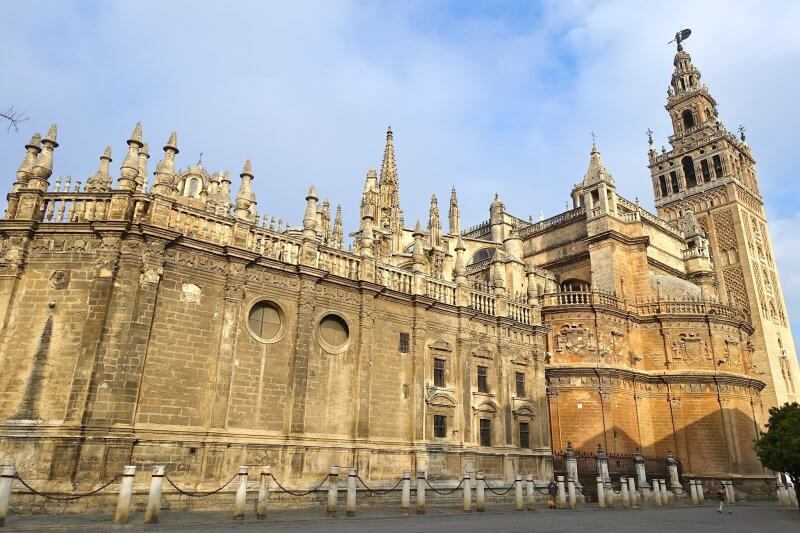The Cathedral of Seville is the largest church in the city, and it is undoubtedly the main symbol not only of the city, but also of Andalusia as a whole.
General information
Seville Cathedral is the main Catholic church in the city, located near the Canal de Alfonso XIII river embankment. For over 500 years (the building was constructed in 1401-1519), the cathedral has stood tall above the rest of the city, and for a long time, it was the tallest structure in the city.
Officially, the Seville Cathedral in Spain is called the Catedral de Sevilla, but it is often referred to as Santa María de la Sede, which means the Christian Church of Santa María de la Sede in Spanish.
Seville Cathedral of Spain is located in the city center, near the river port and the San Telmo Palace. The nearest metro stations are Puerta Jerez and Prado de San Sebastian.
Historical background
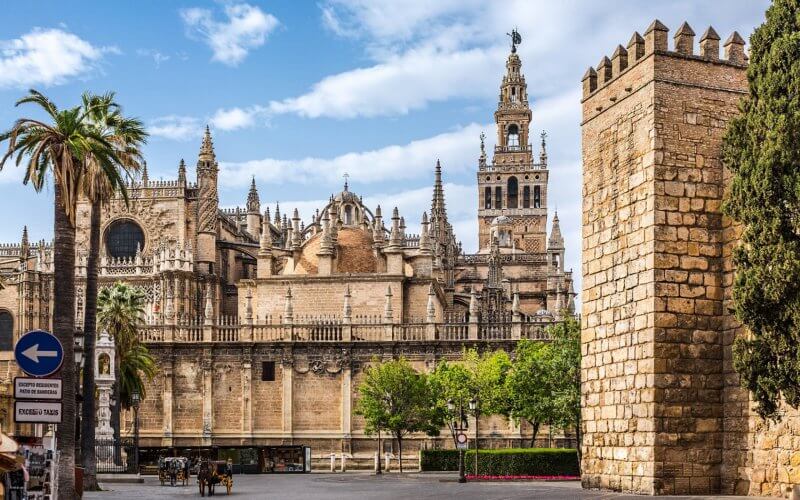
The Cathedral of Seville was built in Spain in the early 15th and 16th centuries on the site of a former Arab mosque. Since the Gothic style was very popular in those years, the architects incorporated its main features into the building, such as a French rosette above the entrance and numerous pointed towers.
The goal was to create the largest cathedral in Europe, which will impress the minds and hearts of people for a long time to come. Since the temple was the main attraction of the city for a long time, the most valuable things brought by Columbus from America were stored here. For example, paintings by Velasquez, Goya and Murillo. For a long time, the remains of the great traveler were also kept in the Seville temple, but at some point historians began to believe that the remains of his son Diego were buried here.
Cathedral architecture
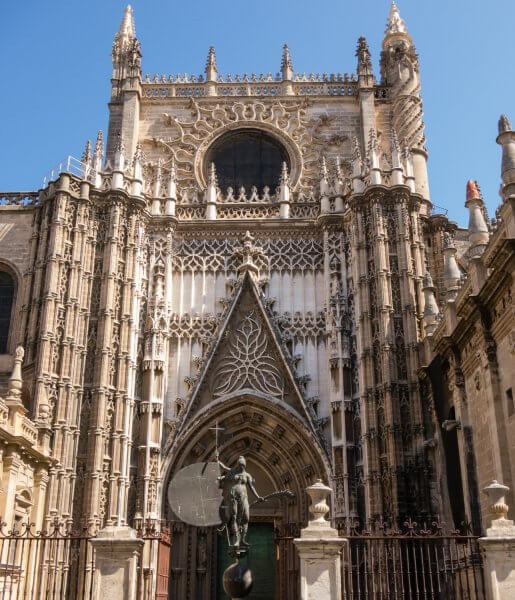
Since the Cathedral of Seville was built on the site of a Muslim mosque that was destroyed during the Reconquista, the cathedral retains some features that are not typical of Spanish Gothic architecture. These include the Gate of Forgiveness (now known as the Puerta del Perdon) and the Giralda Tower, which stands over 114 meters tall. The tower was originally a minaret and housed 22 bells that were used to announce the start of prayer for Muslims. Another surviving detail is a small fountain in the center of the courtyard.
The rest of the cathedral was completely rebuilt. The church consists of five naves, with a total length of just over 120 meters. The central nave is 42 meters high.
Since the cathedral was built in the Gothic style, it has characteristic stained-glass windows, pointed arches, and a French rosette above the entrance. All of this is beautifully complemented by the golden-colored sandstone used in the construction and the terracotta figures of saints that stand near the central entrance.
Interior decoration
The Cathedral of Seville is considered to be the largest in Spain, and it has not only a main hall but also a large number of rooms that contain many relics that are dear to the Spanish people.
Main Chapel
The main chapel is located in the central nave (directly opposite the entrance). Behind an elegant golden grille is the most important treasure – the altar made of walnut and maple wood. This is a unique composition of 45 carved figures, created by the sculptor Dancart and his follower Jorge Fernandez.
Royal Chapel
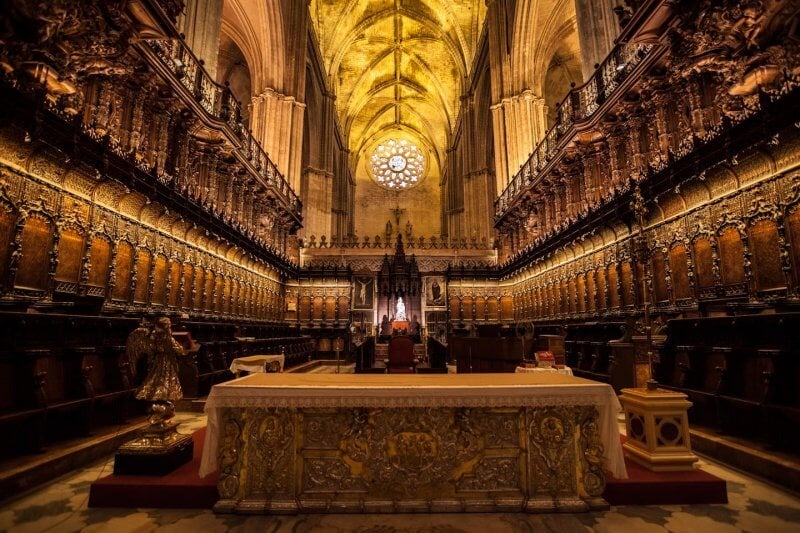
The Royal Chapel is the second oldest chapel in the cathedral. It was built in 1575 and completed in 1580. It houses the remains of several Spanish rulers. Another important feature of the chapel is the statue of the “Royal Madonna,” which is considered the patron saint of the city.
Chapel of San Pedro
The third most famous chapel is the Cathedral of Seville. The room itself is not particularly remarkable, but the paintings on the walls are worth seeing. These are works by the Spanish painter Francisco Zurbarán, who created numerous Baroque and Renaissance paintings. The main subjects are saints.
Main Sacristy
The main sacristy is a repository of masterpieces by Spanish painters, the main exhibit of which is the “Custodia”, made of silver and precious stones. In the same room, there is also a symbolic key that the Moors gave to the new Spanish ruler after his victory.
Sacristy with chalices
This is another room in the cathedral where paintings by Spanish artists are kept. The most famous is Goya’s “Saint Justus and Saint Rufina.” Since this work was painted in Seville, it was decided to keep it here. Other works by Goya, Mateo Pérez, and Velázquez can also be seen in the Sacristy.
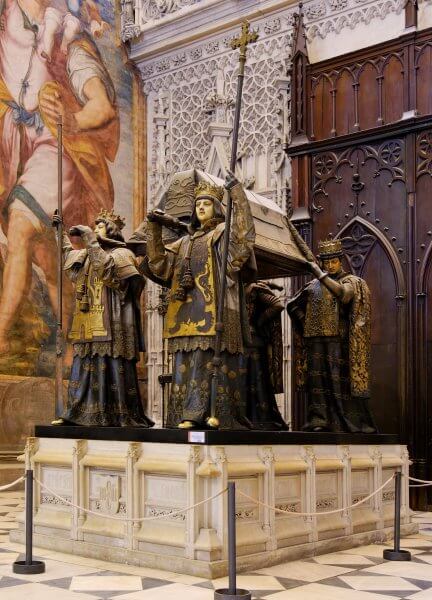
Tomb of Christopher Columbus
One of the most important and little-studied exhibits is the tomb of Christopher Columbus. For centuries, people believed that the remains of the great explorer were indeed buried here, but in the early 21st century, this theory was dismissed. Historians believe that Columbus’s remains were lost somewhere along the way from Santo Domingo, and that his son Diego’s remains are actually buried here.
By the way, the son of Columbus went down in the history of Spain as the creator of the largest (at that time) library, which still contains hundreds of unique books.
Columbian Library
At the moment, the Columbus Library contains over 3 million book volumes – there are both “ordinary” books and incredibly valuable originals. Contrary to popular belief, this is not a separate library, but only one of its many branches.
The Columbus Library in Seville contains important books such as the Book of Columbus’ Prophecies, the Songbook of the Columbus Library, and the Image of the World.
Scalas Chapel
The Scalas Chapel is one of the most richly decorated chapels in the church. It features a number of icons (mostly anonymous), stained glass windows (the most famous being the Descent of the Holy Spirit), and a number of 15th- and 16th-century Italian sculptures. It is also worth noting the intricate patterns on the tombstone of Don Baltazar del Rio, one of the local bishops.
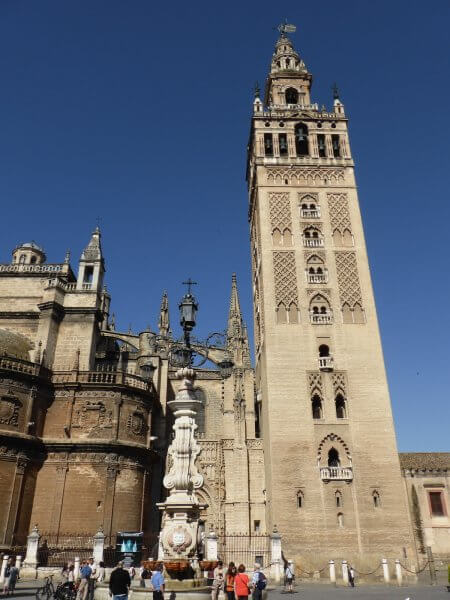
Giralda
The Giralda is the only tower on the cathedral grounds. It used to be a minaret, but now it houses the bells that call the faithful to worship. There is also an observation deck at the top. Getting to the top of the tower is not an easy task, as the passage is very narrow and requires at least 40 steps.
In addition to the above-mentioned rooms, the Cathedral of Seville includes more than 80 chapels and service rooms, most of which are not accessible to tourists.
Organ
In the travel guides on Spain and Seville, where the Seville Cathedral is mentioned, always pay attention to the ancient organ, which appeared in the temple in the early 20th century. Interestingly, over 550 years, the cathedral managed to “visit” as many as 6 organs, which were replaced with newer and more modern ones for various reasons.
Today’s musical instrument is made in the Baroque style, with large golden angels sitting on top and a delicate lattice surrounding the lower pipes.
Practical information
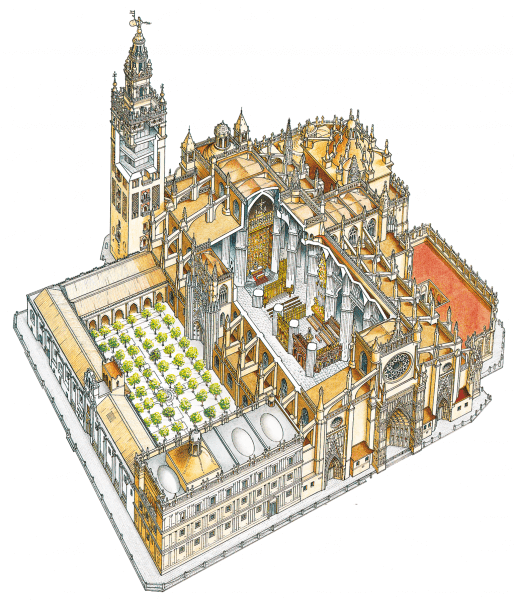
- Location: Av. de la Constitución, s/n, 41004 Sevilla, Spain.
- Opening hours: 08:00-14:00, 16:00-19:00.
- Admission fee: 9 euros for adults, 4 euros for students (an international student card is required) and pensioners, children under 14 years of age – free of charge. It is also possible to purchase a ticket with an excursion-its cost is 16 euros. The price includes an hour-long guided tour of the most interesting parts of Seville Cathedral and a climb to the roof.
- Official website: www.catedraldesevilla.es
Useful tips
- It is worth spending at least 3 hours to visit the Seville Cathedral in Spain – firstly, there are a lot of tourists here, and you will not be able to quickly examine the building. Secondly, the temple is really huge, and it will take at least an hour to examine the most important and famous exhibits.
- Be sure to climb to the cathedral’s observation deck, which offers a beautiful view of the Old Town of Seville.
- Tourists recommend not to spare any money and purchase a ticket with a guided tour. Visiting the cathedral with a guide will not only allow you to learn a lot about the history of Seville, but also to get to know the local traditions better.
- During the evening service, the cathedral can be visited for free, but it is important to note that not all areas will be open, and the hall is usually dimly lit at this time of day.
- It is better to book tickets online on the official website of the cathedral in Spain. The price includes an audio guide.
- After visiting the Cathedral, tourists are recommended to visit the Iglesia de San Salvador, which is the largest Baroque church in Seville.
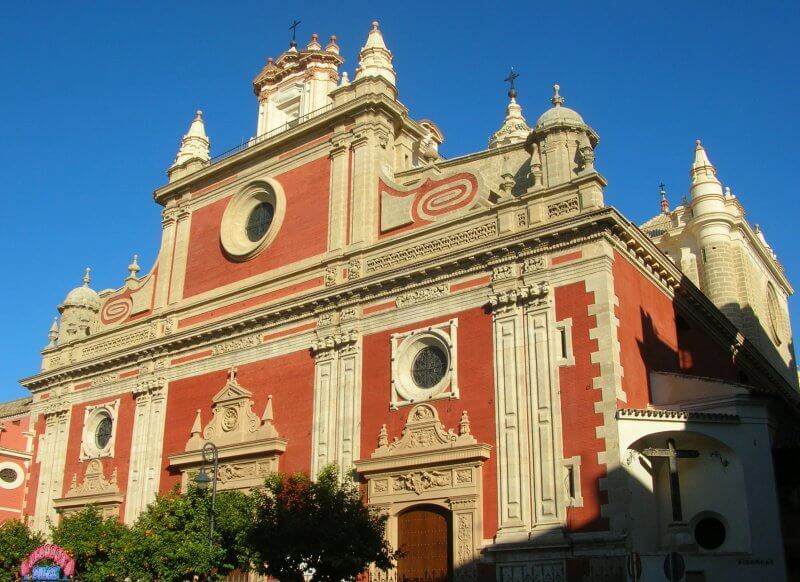
Interesting facts
- Seville Cathedral is the largest Gothic cathedral in Europe.
- According to the architects’ plan, the Cathedral of Seville was supposed to demonstrate the city’s wealth and power, and to strike fear into the hearts of its enemies. In order to build this grandiose structure, the entire city’s treasury was emptied.
- Manuel Blasco de Nebra is the most famous musician who played the organ in the Cathedral of Seville. He held this position until his death.
The Cathedral of Seville is the largest building in Andalusia, and it is an interesting place for both architecture enthusiasts and history lovers.

